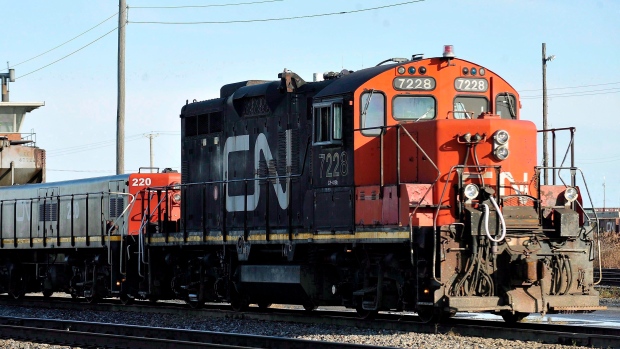Jan 29, 2019
CN Rail’s dividend hike, revenue surge a result of renewed push in Western Canada
The Canadian Press

Canadian National Railway Co.’s (CNR.TO) fourth-quarter revenue growth and subsequent dividend hike came out of a renewed focus on Western Canada, the company’s president and CEO said.
“The focus has really been in Western Canada,” chief executive Jean-Jacques Ruest told BNN Bloomberg in an interview on Wednesday.
“We had a very strong construction season of building sections of double—track in the Canadian Prairies. We have more capacity, which means we can move more freight, more tonnage, especially out west, and we also have a more fluid network, which is also useful for the unit costs.”
CN Rail boosted its dividend by 18 per cent on Tuesday after reporting that its revenues surged 10 per cent in 2018 and forecasting another strong year ahead that builds on burgeoning shipments of oil, coal and grain.
The Montreal-based company will increase the quarterly payout to 53.7 cents on March 29 to shareholders of record on March 8. It also plans to repurchase up to 22 million shares over the coming year.
Ruest told BNN Bloomberg that it was essential that the railroad be in position to anticipate a surge in commodity shipping.
“Being the biggest railroad in Canada we really need to be in position to move the economy and be able to respond to a surge when there is some surge,” Ruest told BNN Bloomberg.
“Right now crude is strong, but also grain is very strong.”
CN Rail's ongoing expansion includes newly expanded rail yards and additional tracks, 1,250 more conductors this winter versus last, and 140 more high-powered locomotives from GE Transport set to arrive in 2019.
The expanded port at Prince Rupert, B.C., where CN has laid track directly on the dock, provides another portal for bolstered exports. It offers shippers a swift route to Asia, avoiding the congestion of Vancouver and Los Angeles.
Meanwhile more grain is being stuffed into shipping containers and dropped on carriers bound for China. CN's grain and fertilizer revenues grew six per cent in 2018 to comprise 18 per cent of total revenue. The company said sales are likely to rise more, with the Transportation Modernization Act that came into effect last May incentivizing rail companies to invest in bigger grain hoppers.
Last quarter, revenue from petroleum and chemicals shot up 50 per cent year over year, driving a 20 per cent increase for the full year to $2.66 billion. With Enbridge's Line 3 not set to come online until late this year and the Trans Mountain expansion facing uncertainty, Canadian railways can expect continued high demand for oil shipments, executives said.
“CN regained its position of strength and demonstrated again its ability to grow at low incremental cost,” Ruest said on a conference call with analysts. “2019 will be a year of building on this momentum.”
Senior vice-president Doug MacDonald said he expects “significant growth” in coal revenues, with two new coal mines adding to traffic and a third that was acquired by CST Canada Coal Ltd. last July slated to start this year.
Coal revenues grew 21 per cent in 2018, mainly from West Coast exports to Asia and from Gulf Coast exports to Europe, MacDonald said.
For the full year, revenues for intermodal grew eight per cent, forest products grew five per cent, metals and minerals grew 11 per cent and automotive grew one per cent.
Forest products and lumber present potential weak points for Canadian railways, with signs of an economic slowdown poised to hit home starts and car purchases.
“A serious downturn in the economy would likely hurt both pricing and volume of goods shipped,” said analyst Dan Sherman of Edward Jones in a note to investors.
During the fourth quarter, the country's largest railway earned $1.09 billion on an adjusted basis or $1.49 per diluted share, beating analysts' expectations. That compares to adjusted earnings of $897 million or $1.20 per diluted share for the quarter ended Dec. 31, 2017.
Net income for the quarter fell 56 per cent to $1.14 billion from $2.61 billion at the same time last year. Revenue rose 16 per cent year over year to $3.81 billion.
Analysts on average had expected an adjusted profit of $1.47 per share for the quarter, according to Thomson Reuters Eikon.
For the full year, net income declined 20 per cent per cent to $4.33 billion because of a deferred income tax recovery a year ago resulting from a lower U.S. federal corporate income tax rate. Adjusted profits were up seven per cent to $4.06 billion or $5.50 per diluted share, compared with $3.8 billion or $4.99 per share in fiscal 2017.
Revenues rose to $14.3 billion in 2018 from $13 billion a year earlier
- With files from BNN Bloomberg





